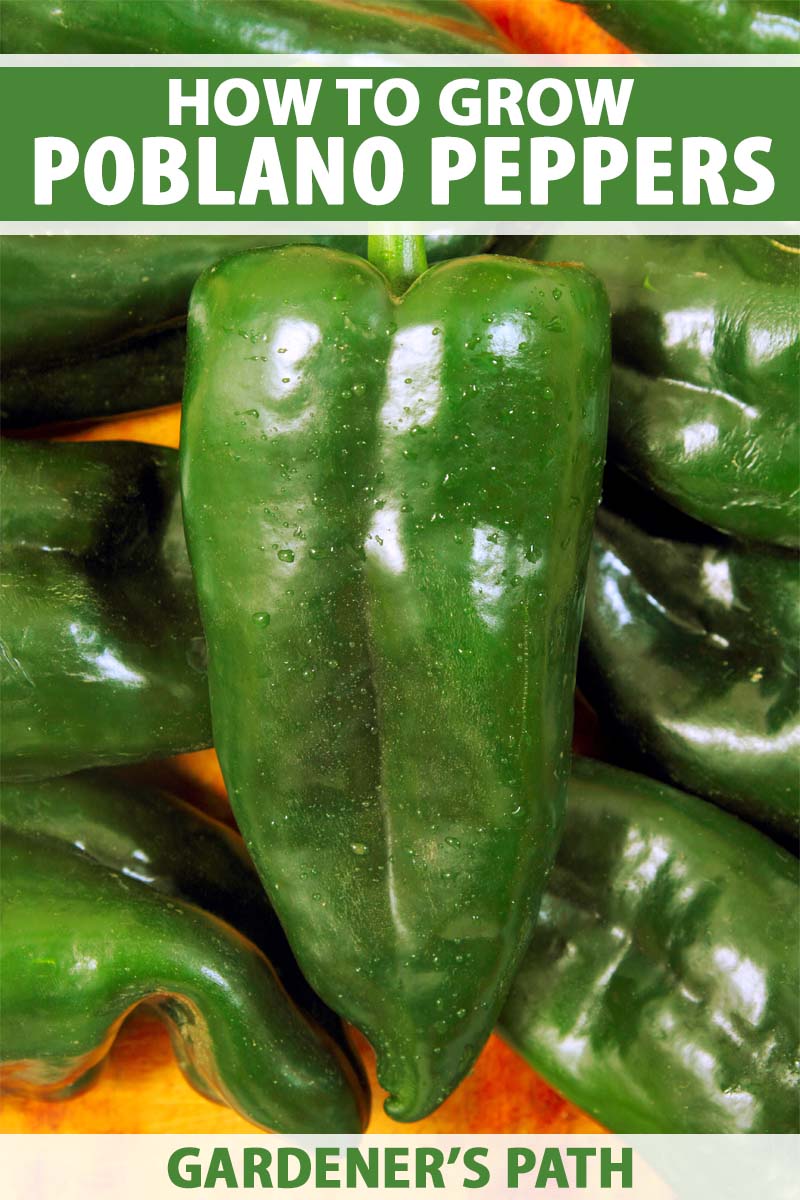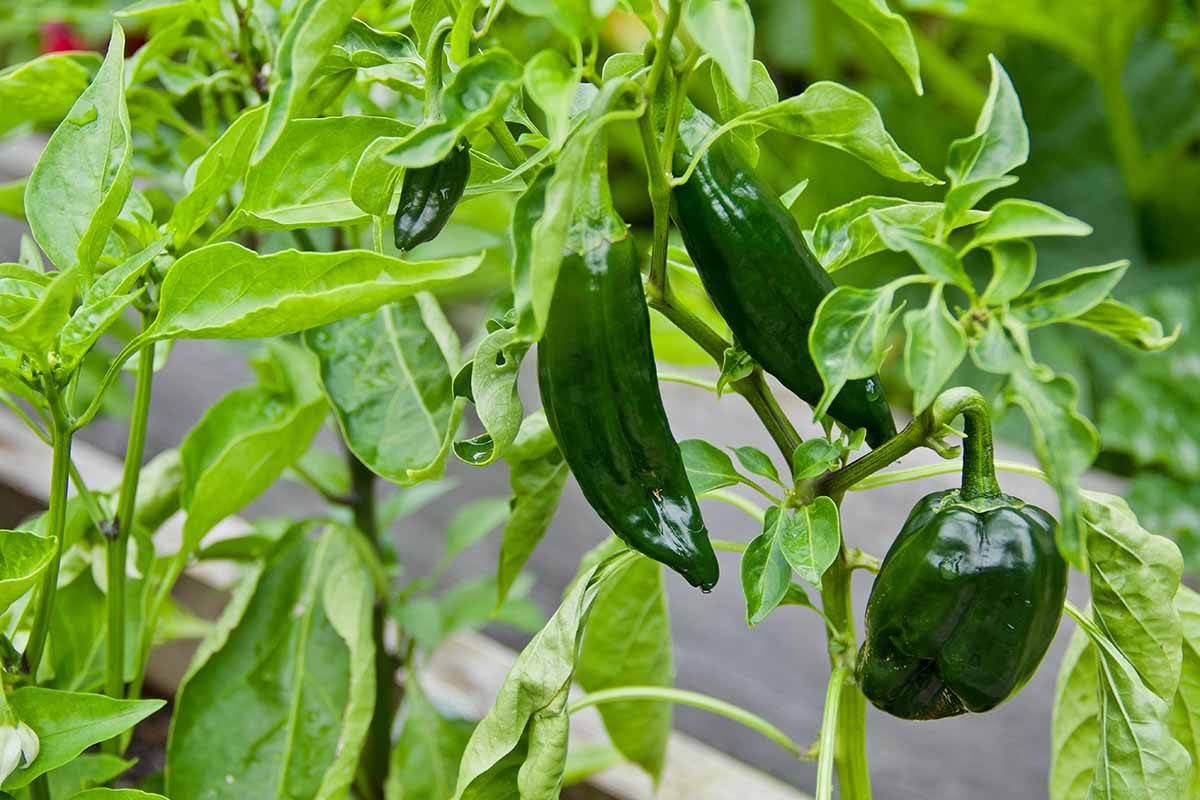To grow poblano peppers, plant them in well-drained soil with full sun and water them regularly. Harvest them when they reach 4-6 inches in length.
Poblano peppers are a popular choice for gardeners due to their mild heat and versatility in cooking. These peppers thrive in warm climates and need plenty of sunlight to grow. Start by planting seeds indoors about 8-10 weeks before the last frost date.
Once seedlings are strong enough, transplant them into your garden or containers with well-drained soil. Water the plants consistently, but avoid waterlogging the soil. Fertilize them every few weeks to support their growth. With proper care, you can enjoy a bountiful harvest of poblano peppers, perfect for roasting, stuffing, or adding to various dishes.
Choosing The Right Seeds
Growing poblano peppers starts with choosing the right seeds. Selecting the best seeds ensures a healthy and bountiful harvest. This section will help you understand the differences between heirloom and hybrid seeds and where to buy them.
Heirloom Vs. Hybrid
Before you purchase seeds, you need to know the difference between heirloom and hybrid seeds. This decision affects your pepper plants’ growth and yield.
| Heirloom Seeds | Hybrid Seeds |
|---|---|
|
|
Heirloom seeds are great for gardeners who value tradition and flavor. They offer a taste passed down through generations. On the other hand, hybrid seeds are engineered for high yields and disease resistance.
Where To Buy
Once you decide on the type of seeds, the next step is to buy them. You can find seeds at various places, both online and offline.
- Local Garden Centers: These stores offer a variety of seeds and expert advice.
- Online Seed Stores: Websites like Amazon and Burpee provide a wide range of options.
- Farmers Markets: They often sell heirloom seeds from local growers.
Buying seeds from reputable sources ensures you get quality seeds. Check reviews and ratings to make an informed choice.
Preparing The Soil
Growing poblano peppers starts with preparing the soil. Healthy soil ensures strong plants and a bountiful harvest. Let’s dive into the essential steps.
Ideal Soil Conditions
Poblano peppers thrive in well-draining soil. The soil should be rich in organic matter. A pH level between 6.2 and 7.0 is perfect.
Check the soil’s pH using a soil test kit. You can buy these kits online or at garden stores.
Soil Amendments
Adding soil amendments improves soil quality. Compost is a great choice. It adds nutrients and improves soil structure.
- Add 2-3 inches of compost to the soil.
- Mix it well into the top 6-8 inches of soil.
You can also add well-rotted manure. This boosts nitrogen levels. Avoid fresh manure as it can harm plants.
For sandy soils, add organic matter like peat moss. This helps retain moisture. For clay soils, add gypsum to improve drainage.
Use the table below to know the best soil amendments:
| Soil Type | Recommended Amendments |
|---|---|
| Sandy | Peat Moss, Compost |
| Clay | Gypsum, Compost |
| Loamy | Compost, Well-Rotted Manure |
Starting Seeds Indoors
Growing Poblano peppers from seeds is an exciting journey. Starting seeds indoors gives your plants a head start. This method ensures strong and healthy plants ready for transplanting. Let’s dive into the essential steps.
Seedling Trays
Using proper seedling trays is crucial for healthy growth. Choose trays with good drainage. Fill them with a high-quality seed starting mix.
- Use individual cells or small pots for each seed.
- Ensure the trays have drainage holes at the bottom.
- Label each tray with the date and type of seed.
Light And Temperature
Light and temperature play key roles in seed germination. Keep the seeds warm and provide adequate light.
- Place the trays in a warm location, around 70°F to 75°F.
- Use a heat mat to maintain consistent warmth.
- Provide 14-16 hours of light daily using grow lights.
Keep the soil moist but not waterlogged. Mist the soil surface to maintain humidity. This setup ensures your Poblano pepper seeds sprout healthily.

Credit: gardenerspath.com
Transplanting Outdoors
Transplanting Poblano peppers outdoors is an essential step in their growth. This process ensures the plants adapt well to their new environment. Follow these steps to help your peppers thrive.
Hardening Off
Before transplanting, you need to harden off your Poblano pepper plants. This process allows them to adjust to outdoor conditions. Start by placing the plants outside for a few hours each day.
Increase the time they spend outside gradually over one to two weeks. This helps them get used to the wind, sun, and fluctuating temperatures. Make sure to bring the plants back indoors at night during this period.
| Day | Time Outside |
|---|---|
| 1-3 | 2-3 hours |
| 4-6 | 4-5 hours |
| 7-9 | 6-7 hours |
| 10-14 | 8+ hours |
Planting Depth
Once your plants are hardened off, it’s time to transplant them. The planting depth is crucial for healthy roots. Dig holes that are deep enough to cover the root ball.
- Ensure the hole is twice the size of the root ball.
- Place the plant in the hole carefully.
- Backfill the hole with soil, covering the roots entirely.
Water the plants well after transplanting. Keep the soil moist but not waterlogged. This helps the roots establish themselves in their new location.
Watering And Fertilizing
Proper watering and fertilizing are crucial for growing healthy poblano peppers. These practices help the plants develop strong roots and produce abundant peppers. Understanding the right techniques will ensure your poblano peppers thrive.
Watering Schedule
Watering poblano peppers requires consistency. They need a steady supply of moisture.
- Initial Stage: Water daily during the first 2 weeks.
- Growth Stage: Water every 2-3 days once the plants are established.
- Soil Check: Keep the soil moist but not waterlogged.
Using a drip irrigation system can be beneficial. It ensures the water reaches the roots directly.
Best Fertilizers
Fertilizing poblano peppers boosts their growth. It supplies essential nutrients.
- Organic Fertilizers: Compost or aged manure is ideal.
- Commercial Fertilizers: Choose a balanced 10-10-10 fertilizer.
- Application Frequency: Fertilize every 4-6 weeks during the growing season.
Avoid over-fertilizing. It can harm the plants and reduce pepper yield.
| Stage | Watering Frequency | Fertilizer Type |
|---|---|---|
| Initial | Daily | Organic Compost |
| Growth | Every 2-3 days | 10-10-10 Fertilizer |
Following these guidelines will help your poblano peppers grow strong and healthy.

Credit: gardenerspath.com
Managing Pests And Diseases
Proper management of pests and diseases is crucial for healthy poblano peppers. This section provides insights on common pests and disease prevention methods.
Common Pests
Poblano peppers often face threats from various pests. Below is a list of common pests that could affect your crops:
- Aphids: These tiny insects suck sap from leaves and stems.
- Spider Mites: These cause yellowing and stippling on leaves.
- Whiteflies: Small white insects that weaken plants by sucking juices.
- Cutworms: These pests cut seedlings at the soil level.
Regularly inspect plants to catch infestations early. Use organic insecticidal soap for aphids and spider mites. For cutworms, place collars around seedlings.
Disease Prevention
Preventing diseases in your poblano peppers is easier than treating them. Follow these tips to keep your plants healthy:
- Crop Rotation: Avoid planting peppers in the same spot every year.
- Proper Spacing: Ensure good air circulation by spacing plants well.
- Watering: Water at the base to keep leaves dry and prevent fungal growth.
- Mulching: Use organic mulch to retain soil moisture and block weeds.
Common diseases include blossom end rot and bacterial leaf spot. For blossom end rot, ensure consistent watering and calcium levels. If bacterial leaf spot appears, remove affected leaves and apply copper-based fungicides.
| Disease | Symptoms | Prevention |
|---|---|---|
| Blossom End Rot | Dark spots on fruit bottoms | Consistent watering, calcium supplements |
| Bacterial Leaf Spot | Dark, water-soaked spots on leaves | Remove affected leaves, use copper fungicides |
Monitor your plants regularly. Early detection and action can save your crops from severe damage.
Harvesting Poblano Peppers
Harvesting Poblano Peppers is a key step in enjoying this flavorful vegetable. Knowing the right time and method ensures you get the best taste and yield.
When To Harvest
Poblano peppers are ready for harvest when they are dark green. They should be about 4 to 6 inches long. The skin should be firm and glossy. If left on the plant, they will turn red and become sweeter.
Proper Harvest Techniques
To harvest, use clean, sharp scissors or garden shears. Cut the stem about half an inch above the pepper. Be gentle to avoid damaging the plant.
- Inspect the plant for ripe peppers.
- Hold the pepper firmly.
- Cut the stem cleanly.
After harvesting, store the peppers in a cool, dry place. They can last up to two weeks in the refrigerator. For longer storage, consider drying or freezing them.
| Stage | Characteristics | Best Use |
|---|---|---|
| Green | Firm, glossy | Fresh cooking, grilling |
| Red | Softer, sweeter | Drying, sauces |
Storing And Using Poblano Peppers
Poblano peppers are versatile and flavorful. Proper storage extends their shelf life. Using them in various dishes can elevate your meals. Below, you will find tips on storing and using these peppers effectively.
Storage Methods
Proper storage is key to keeping poblano peppers fresh. Here are some methods:
- Refrigeration: Place unwashed poblano peppers in a plastic bag. Store them in the crisper drawer. They can last up to two weeks.
- Freezing: Wash, core, and slice the peppers. Spread them on a baking sheet. Freeze until solid. Transfer to a freezer bag. They can last up to six months.
- Drying: String the peppers and hang them in a dry, warm place. This method preserves them for several months.
Culinary Uses
Poblano peppers add a rich, smoky flavor to dishes. Here are some popular uses:
- Stuffed Peppers: Fill with cheese, meat, or rice. Bake until tender.
- Roasted: Char the skin on an open flame. Peel, chop, and add to salsas or soups.
- Chiles Rellenos: Stuff with cheese, batter, and fry until golden.
- Soups and Stews: Add chopped poblanos for a smoky flavor.
- Rajas: Slice and sauté with onions and cream. Serve as a side dish.
These storage methods and culinary uses ensure you make the most of your poblano peppers. Enjoy their unique flavor in various dishes!

Credit: m.youtube.com
Frequently Asked Questions
How Do You Start Poblano Peppers?
Start poblano peppers from seeds indoors 8-10 weeks before the last frost. Use well-draining soil and provide adequate light.
What Soil Is Best For Poblano Peppers?
Poblano peppers thrive in well-draining, loamy soil rich in organic matter. Ensure the soil pH is between 6. 0 and 6. 8.
How Much Sunlight Do Poblano Peppers Need?
Poblano peppers need full sunlight, at least 6-8 hours daily. This ensures healthy growth and optimal pepper production.
When Should You Harvest Poblano Peppers?
Harvest poblano peppers when they are dark green and firm. This usually occurs 65-80 days after planting.
Conclusion
Growing poblano peppers can be a rewarding experience. Follow the steps outlined for optimal results. Enjoy fresh, homegrown peppers all season long. Experiment with different recipes to fully appreciate their flavor. Happy gardening and savor the fruits of your labor!
